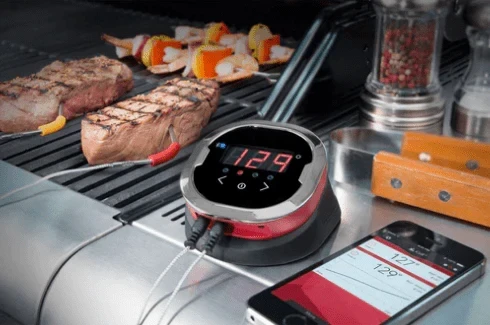Email format error
Email cannot be empty
Email already exists
6-20 characters(letters plus numbers only)
The password is inconsistent
Email format error
Email cannot be empty
Email does not exist
6-20 characters(letters plus numbers only)
The password is inconsistent


Using a Meat Thermometer for Roast Beef: A Comprehensive Guide
Cooking the perfect roast beef can be a daunting task, even for seasoned chefs. One of the most essential tools for achieving that perfect roast is a meat thermometer. In this guide, we'll delve deep into the importance of using a meat thermometer for roast beef, how to use it effectively, and other tips and tricks to ensure your roast beef is always cooked to perfection.
Why Use a Meat Thermometer for Roast Beef?
Using a meat thermometer for roast beef is crucial for several reasons. Firstly, it ensures that your beef is cooked to the desired level of doneness, whether that's rare, medium-rare, or well-done. Secondly, it helps prevent overcooking, which can result in a dry, tough roast. Lastly, a meat thermometer ensures food safety by making sure the meat reaches a temperature that kills harmful bacteria.
Achieving the Perfect Doneness
Different people have different preferences when it comes to the doneness of their roast beef. Using a meat thermometer allows you to cater to these preferences precisely. Here's a quick guide to the internal temperatures required for different levels of doneness:
● Rare: 120°F to 125°F (49°C to 52°C)
● Medium Rare: 130°F to 135°F (54°C to 57°C)
● Medium: 140°F to 145°F (60°C to 63°C)
● Medium Well: 150°F to 155°F (66°C to 68°C)
● Well Done: 160°F and above (71°C and above)
By using a meat thermometer for roast beef, you can ensure your roast reaches the exact temperature for your preferred doneness.
Ensuring Food Safety
Undercooked beef can harbor harmful bacteria such as E. coli and Salmonella. Using a meat thermometer ensures that the meat reaches a safe internal temperature, reducing the risk of foodborne illness. The USDA recommends a minimum internal temperature of 145°F (63°C) for beef, followed by a three-minute rest period.
Types of Meat Thermometers
There are several types of meat thermometers available on the market, each with its own set of features and benefits. Here, we'll explore the most common types and how to use them effectively for roast beef.
Instant-Read Thermometers
Instant-read thermometers provide a quick temperature reading, usually within a few seconds. They are ideal for checking the internal temperature of roast beef without leaving the thermometer in the meat while it cooks. To use an instant-read thermometer, insert the probe into the thickest part of the roast and wait for the temperature to stabilize.
Leave-In Probe Thermometers
Leave-in probe thermometers are designed to be inserted into the meat and left in place throughout the cooking process. These thermometers usually come with a digital display that remains outside the oven, allowing you to monitor the temperature without opening the oven door. This type of thermometer is particularly useful for roast beef as it provides continuous temperature monitoring.
Wireless Remote Thermometers
Wireless remote thermometers take convenience to the next level by allowing you to monitor the temperature of your roast beef from a distance. These thermometers come with a probe that remains in the meat and a wireless receiver that you can carry around with you. Some models even come with smartphone connectivity, sending alerts when your roast reaches the desired temperature.
Oven-Safe Dial Thermometers
Oven-safe dial thermometers are traditional meat thermometers with a dial that can withstand oven temperatures. They are inserted into the meat and left in place during cooking. While they are not as quick or precise as digital thermometers, they are still a reliable option for using a meat thermometer for roast beef.
How to Use a Meat Thermometer for Roast Beef
Using a meat thermometer may seem straightforward, but there are a few key tips and techniques to ensure accurate readings and perfect results.
Preparing the Roast
Before using a meat thermometer, it's important to properly prepare the roast. This includes seasoning the meat, bringing it to room temperature, and preheating your oven. Season your roast with your preferred herbs and spices, then let it sit at room temperature for about 30 minutes to ensure even cooking.
Inserting the Thermometer
For accurate readings, it's crucial to insert the thermometer into the right part of the roast. Insert the probe into the thickest part of the meat, avoiding bones and fat, which can give inaccurate readings. Make sure the tip of the thermometer is in the center of the roast for the most precise measurement.
Monitoring the Temperature
As your roast beef cooks, use your meat thermometer to monitor the internal temperature. For instant-read thermometers, check the temperature periodically by inserting the probe into the meat. For leave-in probe or wireless thermometers, simply keep an eye on the digital display or receiver.
Resting the Meat
Once your roast beef reaches the desired internal temperature, remove it from the oven and let it rest. Resting allows the juices to redistribute throughout the meat, resulting in a juicier and more flavorful roast. During this time, the internal temperature may rise slightly, so keep this in mind when using a meat thermometer for roast beef.
Tips for Perfect Roast Beef
Using a meat thermometer for roast beef is a game-changer, but there are additional tips and techniques that can elevate your roast to the next level.
Choosing the Right Cut
The cut of beef you choose can significantly impact the flavor and texture of your roast. Popular cuts for roasting include ribeye, sirloin, and tenderloin. Each cut has its own unique characteristics, so choose one that suits your taste and cooking method.
Seasoning and Marinating
Proper seasoning is key to a flavorful roast beef. Simple seasonings like salt, pepper, and garlic can enhance the natural flavors of the meat. For extra flavor, consider marinating your roast overnight in a mixture of olive oil, herbs, and spices.
Searing the Meat
Searing the roast before cooking can add a delicious crust and lock in the juices. Heat a skillet over high heat, add a bit of oil, and sear the roast on all sides until browned. This step is especially beneficial for larger cuts of beef.
Using a Roasting Rack
A roasting rack elevates the meat, allowing air to circulate and ensuring even cooking. It also prevents the bottom of the roast from sitting in its own juices, which can lead to a soggy texture.
Basting for Moisture
Basting the roast with its own juices or a marinade can help keep the meat moist and flavorful. Use a spoon or baster to pour the juices over the roast every 30 minutes or so during cooking.
Troubleshooting Common Issues
Even with the best techniques, sometimes things can go wrong. Here are some common issues when using a meat thermometer for roast beef and how to troubleshoot them.
Inaccurate Readings
If your thermometer is giving inaccurate readings, it could be due to several factors. Make sure the probe is inserted into the thickest part of the meat and not touching bone or fat. Also, check the calibration of your thermometer by placing it in ice water and boiling water to see if it gives the correct temperatures (32°F and 212°F respectively).
Overcooking
If your roast beef is consistently overcooked, consider lowering the oven temperature or shortening the cooking time. Remember that the internal temperature will continue to rise slightly during the resting period.
Dry Meat
Dry roast beef can be the result of overcooking or using a lean cut of meat. To prevent this, use a cut with more marbling, such as ribeye or chuck, and avoid cooking past medium doneness. Additionally, consider basting the meat and letting it rest after cooking to retain moisture.
Uneven Cooking
Uneven cooking can occur if the roast is not brought to room temperature before cooking or if it's not cooked on a roasting rack. Ensure the meat is at room temperature and use a rack to promote even cooking.
Conclusion
Using a meat thermometer for roast beef is an indispensable technique for achieving perfectly cooked meat every time. By selecting the right type of thermometer, properly preparing and monitoring your roast, and following additional tips and techniques, you can ensure that your roast beef is always cooked to perfection. Remember, practice makes perfect, so don't be afraid to experiment with different cuts, seasonings, and cooking methods to find what works best for you. Happy roasting!

